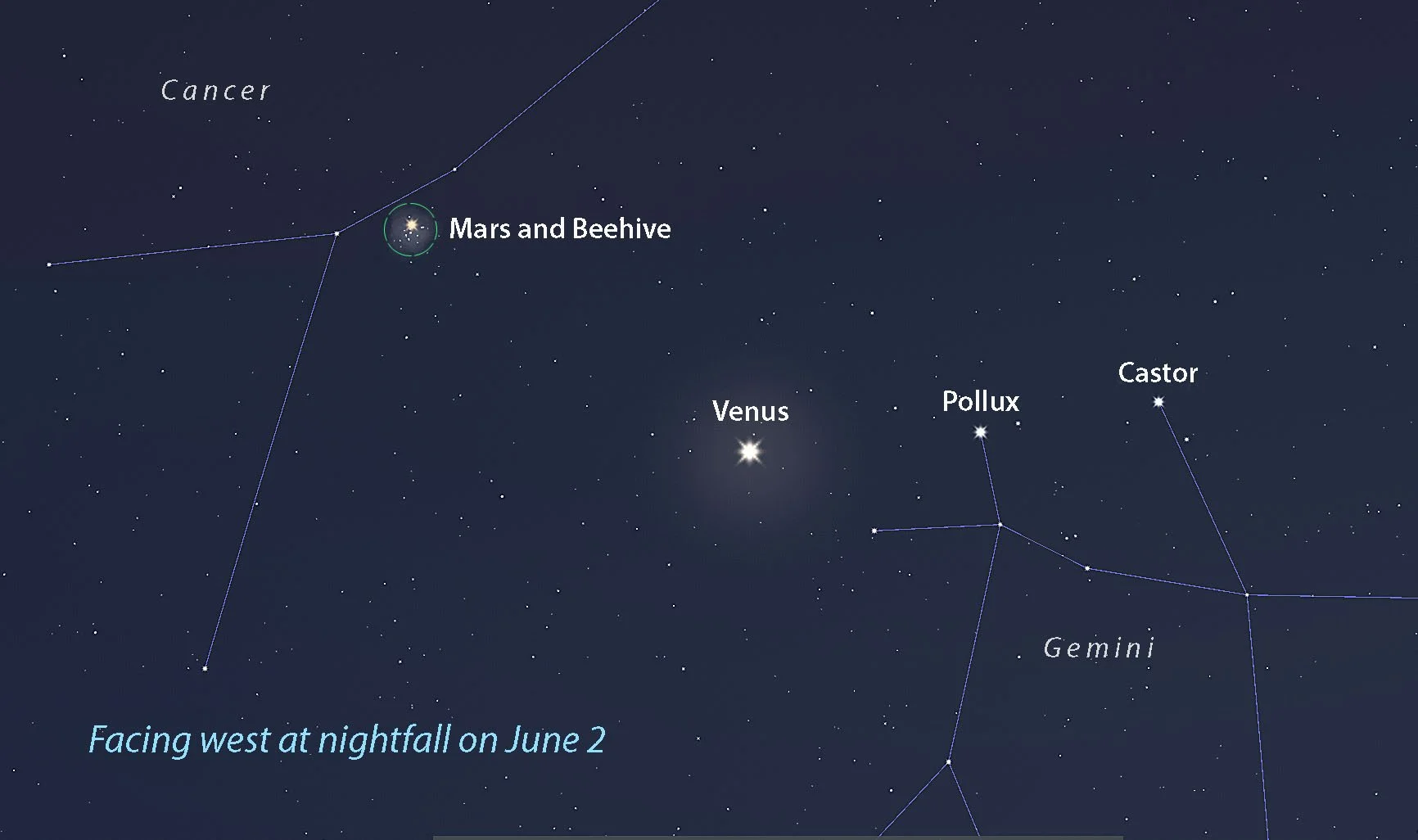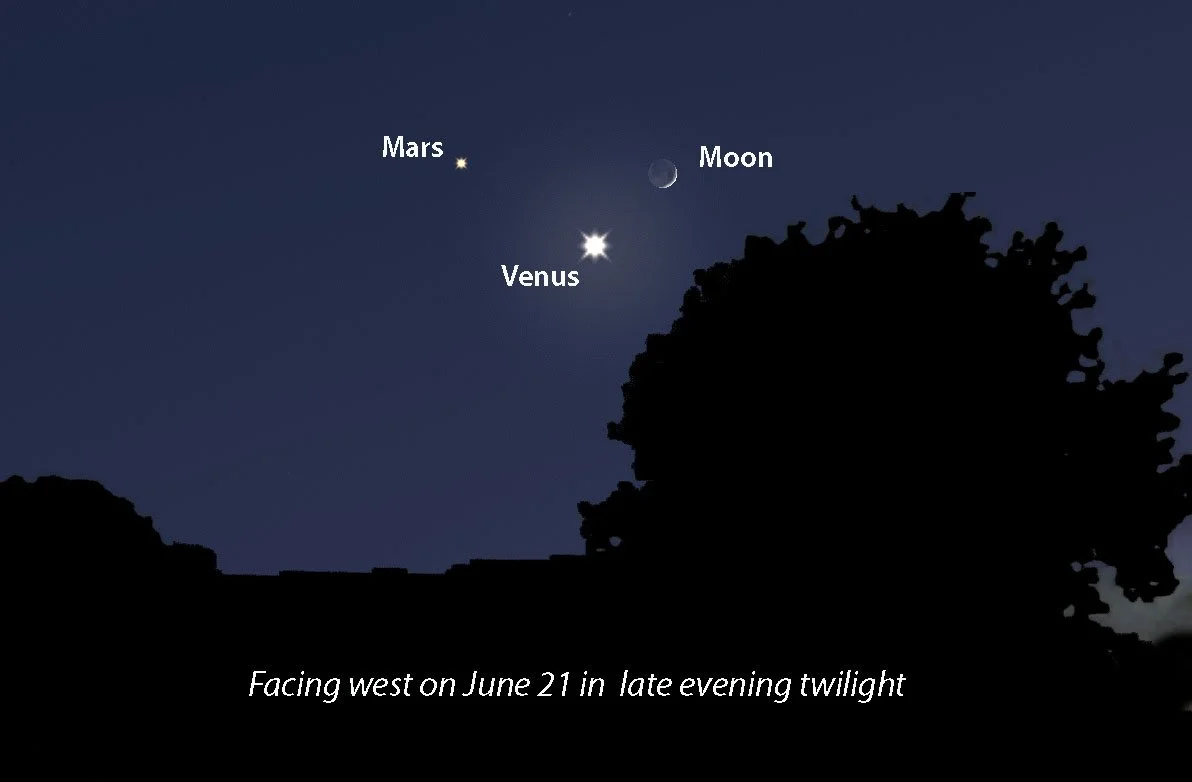June 2023 Night Sky Calendar
With the summer solstice arriving on June 21, we experience the shortest nights and longest days of the year this month along with summer astronomy’s nemesis, the mosquito. When you go out stargazing be sure to protect yourself. I’d hate for you to miss all the wonderful things coming our way.
Venus, the brilliant planet in the western sky at dusk, chases fainter Mars all month but fails to catch up to it. On June 1 st the duo will be 10.5° apart, the width of a fist held at arm’s length. They’ll be closest at month’s end with the Red Planet just 3.5° to the upper left of Venus. As July opens, they’ll slowly separate with Mars continuing on its merry way east and Venus headed back toward the sun.
Saturn brightens in June and climbs higher in the sky during the early morning hours in the constellation Aquarius. The best time to see it is at the start of dawn. Look for a solitary bright star about three “fists” high in the southeastern sky around 3:30-4 a.m. local time.
A new planet joins the crew this month — Jupiter. At midmonth it shines low in the eastern sky in Aries the Ram during morning twilight. On the 14 the waning crescent moon joins the gas giant in a spectacular conjunction. Find a location with a good view to the east and start watching 75 minutes to an hour before sunrise.
Events:
June 1-2 – Mars meets the Beehive Cluster! The Red Planet, shining modestly at magnitude 1.6, appears at the cluster’s western border on June 1 and then slips inside of it the following night (June 2). Although you can see the Beehive with the naked eye as a faint, fuzzy patch from a dark sky you’ll need binoculars or a small telescope this time around because of the nearly full moon. Point your binoculars at Mars and look around it for a sprinkling of stars. The Beehive is in Cancer the Crab and located about 610 light-years from Earth.
June 1-2 – Venus forms a straight, nearly horizontal line with Gemini’s brightest stars Pollux and Castor. Pollux is one of the brightest stars in the night sky orbited by a planet. Named Thestias, it’s at least twice as massive as Jupiter and orbits the star every 1.6 years.
June 3 – Full Strawberry Moon. Watch for it to rise around sunset in Scorpius just a few degrees east of the constellation’s brightest star, Antares.
June 4 – Venus at greatest eastern elongation from the sun (45°)
June 10 – Last quarter moon
June 12-13 – It’s Venus’s turn to visit the Beehive. The brilliant planet cruises less than a degree north (above) the cluster’s center on both nights. Use binoculars or a small telescope.
June 14 (dawn) – Waning crescent moon and Jupiter snuggle next to each other in a lovely conjunction low in the eastern sky during morning twilight. They’ll be about 3° apart. Mid-month to late June – Watch China’s Tiangong space station cross the southern sky during evening hours. It will look like a slowly-moving bright star traveling west to east. For when and where to look, go to heavens-above.com, click on the blue link to add your observing location then return to the home page and click on the blue Tiangong link.
June 17 – New moon
June 21 – Summer solstice at 9:57 a.m. Central Daylight Time. The sun reaches it highest point in the sky. Longest day and shortest night of the year for northern hemisphere residents. First day of winter if you live in the southern hemisphere.
June 21 – A thin, waxing lunar crescent will not only be in conjunction just 2.5° above Venus tonight, but Mars will shine nearby (4.5° to the upper left) in a picturesque threesome.
June 25 – First quarter moon
June 30 – Waxing gibbous moon 2.5° to the right (west) of Antares in Scorpius
Bob King is an amateur astronomer, author, and passionate educator. He served as a photographer and photo editor at the Duluth News Tribune for 39 years and taught at the UMD planetarium. Bob’s work had a great impact on Voyageurs National Park. To achieve International Dark Sky Park certification, the park was required to host dark sky education events. Through the Night Sky Explorer webinars, the Conservancy was able to fulfill this component and help secure the certification for Voyageurs National Park. We can’t thank Bob King enough for sharing his talents and knowledge with the Conservancy community to support dark sky preservation.






